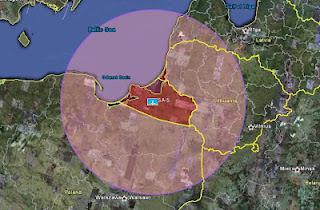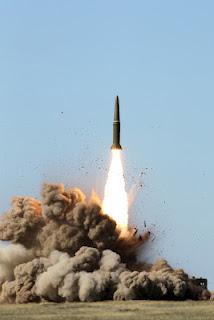 On Thursday, General Nikolai Makarov, Russia’s most senior military commander, warned
NATO that if it proceeded with its missile defence system in Europe, Moscow would use force
against it. According to Makarov, Russia may counter NATO deployment by stationing
short-range Iskander missiles in the Russian Kaliningrad exclave, on the Baltic Sea. “The deployment of new strike weapons in Russia’s south and northwest - including
Iskander systems in Kaliningrad - is one of our
possible options for destroying the system’s European infrastructure,” the
General said, while speaking at a conference in Moscow on anti-ballistic missile policy.
On Thursday, General Nikolai Makarov, Russia’s most senior military commander, warned
NATO that if it proceeded with its missile defence system in Europe, Moscow would use force
against it. According to Makarov, Russia may counter NATO deployment by stationing
short-range Iskander missiles in the Russian Kaliningrad exclave, on the Baltic Sea. “The deployment of new strike weapons in Russia’s south and northwest - including
Iskander systems in Kaliningrad - is one of our
possible options for destroying the system’s European infrastructure,” the
General said, while speaking at a conference in Moscow on anti-ballistic missile policy.
While Russian officials have said previously that the anti-missile sites could become targets in the event of war, the threat of a pre-emptive attack was new, and might signal a shift to a more muscular foreign policy than that pursued by Russia’s outgoing President, Dmitry Medvedev. In the last days, Russian Defense Minister Anatoly Serdyukov also warned that talks between Moscow and Washington on the NATO missile shield are “close to a dead end”. US missile defense plans in Europe have been one of the touchiest subjects in NATO-Russian relations for years, as Moscow fears the system will eventually become powerful enough to undermine Russia’s nuclear deterrent. Hence the importance of Kaliningrad.
The Russian exclave, strategically located between NATO members Poland and Lithuania, is a thornin the side of the Alliance. Circled by the Chernyakhovsk and Donskoye air bases, and the Kaliningrad Chkalovsk naval air base, Kaliningrad is one of the most militarily protected areas of the Russian Federation, and the only region from where Russia’s Iskander missiles may actually penetrate US planned missile shield, which will include interceptor missiles based in Poland and Romania, a radar system in Turkey and missile-defense capable warships at sea.
LAUNCH OF A 9K720 ISKANDER MISSILE
 Superior to its predecessor, the Oka, the Iskander system is equipped with two
solid-propellant single-stage guided missiles, each one of which is controlled
throughout the entire flight path and fitted with a non-separable warhead. Each
missile in the launch carrier vehicle can be also independently targeted in a
matter of seconds and even re-targeted during flight in the case of engaging
mobile targets. Such features, which ensure high accuracy, mobility and
reliability, make the Iskander an ideal tactical missile system to be used in
theater level conflicts.
Superior to its predecessor, the Oka, the Iskander system is equipped with two
solid-propellant single-stage guided missiles, each one of which is controlled
throughout the entire flight path and fitted with a non-separable warhead. Each
missile in the launch carrier vehicle can be also independently targeted in a
matter of seconds and even re-targeted during flight in the case of engaging
mobile targets. Such features, which ensure high accuracy, mobility and
reliability, make the Iskander an ideal tactical missile system to be used in
theater level conflicts.
In 1999, the Russian military staged “Zapad-99” (West-99), a large-scale exercise with a scenario whereby NATO imposes an air/sea blockade of Kaliningrad and then begins an offensive with bombers and cruise missiles. The Russian conventional defenses are breached and, to resolve the situation, Moscow carries out a preventive nuclear attack using four long-range cruse missiles launched by strategic bombers. Two nuclear warheads hit targets in Western Europe and two in the United States. The decision to use air-launched nuclear cruise missiles is preferable, because even a limited launch of intercontinental ballistic missiles could trigger an immediate launch of US ICBMs.
The Zapad-99 exercise ended with Russia victorious. Baffled by the limited preventive nuclear strike and faced with the choice to either begin an all-out global nuclear war or back down, NATO stopped its attack on Kaliningrad. After Zapad-99, Moscow accepted that preventive nuclear strikes would be the best way to stop a NATO attack that Russia’s weak conventional forces cannot repulse. Makarov’s recent remarks fit perfectly in this approach, though the construction of a US-led missile defense system in Europe is not perceived by Russia just as a conventional threat, but as the main strategic challenge to its nuclear deterrent since the end of the Cold War. A challenge Moscow is determined to win at any cost.

